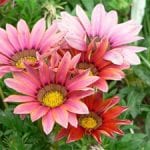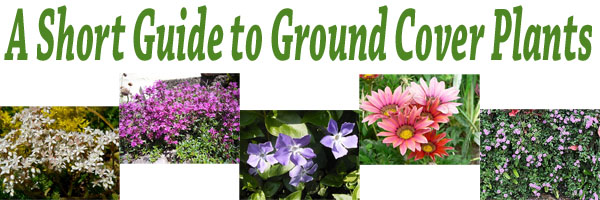Newsletter Articles
A Short Guide to Ground Cover Plants
Written by David S.
Ground covers are a beautiful way to solve landscaping problems. Maybe it is that bare spot under a tree where lawn will not grow or the starkness of a terrace that needs softening. Perhaps you have an erosion issue or want to give a gentle reminder of where to walk and where not to.
The Positives
Ground covers are usually low maintenance, and they do an excellent job of filling in spots where other plants may not grow. Most are drought tolerant and will need less watering once they establish themselves. Outside of grasses, most bloom and many for an extended time. They work well to hide eyesores in the yard, such as your home’s foundation. They are also an easy way to add a bit of drama to your landscape. In this, it is the draping plants that become the stars of planters and rock gardens.
If there is a problem with ground covers, it is that they can sometimes be overly aggressive growers. They may crowd other plants, but it is usually easy to keep them in check.
Considerations for Growing Ground Cover Plants
Soil – Be sure to test the soil pH and have a close look at the texture of the soil. Doing so will help you determine whether the soil needs amending.
Plant Selection – Choose the best plant for your project. Some ground cover plants grow too quickly and will overwhelm other plants, including other ground cover plants. For this reason, pair mixed plantings with plants that grow at a similar rate. Be sure to ask our plant and garden experts for advice.
Match the Plant to the Project – Ground cover plants are either carpeting plants, meaning they are low growing and spread quickly, or clumping. Most clumping plants spread more slowly then carpeting ground covers. A good tip is for the drooping and draping look a carpeting ground cover will give you more bang for your buck.
Choose the Right Number of Plants – For clumping ground cover plants, give them about 1.5-feet of space in which to grow. For carpeting plants, give them about 2-feet of space. You can err on the side of caution with carpeting plants as many will keep expanding. You can always trim them back.
Prepare the Soil – be sure to remove weeds. Most of these plants grow in just a few inches of soil, but make sure to dig down about 6-inches so that you have room for soil amendments. Now is also the time to adjust the pH of the soil if needed. Lime is a good product if you need to raise the pH of the soil. Aluminum Sulfate is a good product if you need to lower the pH of the soil. Ask our garden experts about soil products that affect pH.
Consider soil products, such as Salamander Soil for plants in full sun. Salamander Soil by FoxFarms holds moisture and that is helpful when plants are still transitioning. The best time to add soil products is as you prepare the ground.
Note: If your soil is light brown or tan, consider adding an amendment with compost or organic material in it. Plants do better when the soil is perfect. Another consideration for changing the soil pH is that the beneficial organisms prefer almost neutral soil. Those organisms help improve plant health.
Plant the Ground Covers – When the soil is ready, you can plant your plants. You can consider adding a thin layer of mulch while the plants are establishing themselves. One of the many beautiful things about most of the ground cover plant is that they eventually become their own “mulch.”
Some of Our Favorite Ground Covers
 1. Periwinkle – Vinca major – Beautiful extended blooming ground cover that reaches about 12-18 in height. Very drought tolerant when established and shows with beautiful periwinkle blooms. Periwinkle grows in full sun or partial shade.
1. Periwinkle – Vinca major – Beautiful extended blooming ground cover that reaches about 12-18 in height. Very drought tolerant when established and shows with beautiful periwinkle blooms. Periwinkle grows in full sun or partial shade.
 2. Sedum – Sedum is the family name for a large group of succulents. These are slow to spread, but they make one of the most beautiful ground covers. They grow well in rock gardens, open areas where there is not a lot of competition from taller plants or weeds, in pots, and under trees. Many tolerate partial shade, but also prefer full sun.
2. Sedum – Sedum is the family name for a large group of succulents. These are slow to spread, but they make one of the most beautiful ground covers. They grow well in rock gardens, open areas where there is not a lot of competition from taller plants or weeds, in pots, and under trees. Many tolerate partial shade, but also prefer full sun.
 3. Creeping Thyme – Available in a wide array of colors, this plant is quite striking when established. A bonus, bees love thyme. The foliage is small-leaved and comes in many shades of green. Thyme is a durable plant that is also drought tolerant. It will handle some foot traffic, making an excellent choice for along pathways. Creeping thyme is a carpet-type ground cover.
3. Creeping Thyme – Available in a wide array of colors, this plant is quite striking when established. A bonus, bees love thyme. The foliage is small-leaved and comes in many shades of green. Thyme is a durable plant that is also drought tolerant. It will handle some foot traffic, making an excellent choice for along pathways. Creeping thyme is a carpet-type ground cover.
 4. Trailing Lantana – Lantana is a beautiful and dynamic group of plants. Make sure for ground cover projects that you choose a trailing variety, which tops out around 18″ tall. The other types may reach six feet in height. Lantana is a very drought tolerant once established, and it spreads upwards of five feet in width. It works well as a barrier and will cover bare spots in landscaping. Trailing lantana usually has either white or purple flower clusters that bloom throughout the summer.
4. Trailing Lantana – Lantana is a beautiful and dynamic group of plants. Make sure for ground cover projects that you choose a trailing variety, which tops out around 18″ tall. The other types may reach six feet in height. Lantana is a very drought tolerant once established, and it spreads upwards of five feet in width. It works well as a barrier and will cover bare spots in landscaping. Trailing lantana usually has either white or purple flower clusters that bloom throughout the summer.
 5. Gazanias – These beautiful plants are from Africa, and they thrill us with large flowers in a mix of colors. They are perfect for full-sun locations where you want to add color. They come in a wide array of color options, and some are variegated. They do best in neutral soil that is sandy and well-drained.
5. Gazanias – These beautiful plants are from Africa, and they thrill us with large flowers in a mix of colors. They are perfect for full-sun locations where you want to add color. They come in a wide array of color options, and some are variegated. They do best in neutral soil that is sandy and well-drained.
The list of ground cover plants is extensive. Stop by one of our five Southern California nurseries and explore the options. Our garden experts are happy to make recommendations, show you the soil pH testers, and supplements for ground cover plants.
Keep in mind that our inventory changes at each location daily. If you have a specific product or plant that you want, call ahead, and check on availability. You can also shop online too. We also love visitors, so stop by and chat with the garden experts about your project.
Do you like what you see? Sign up for our weekly newsletter to get content like this every week!

